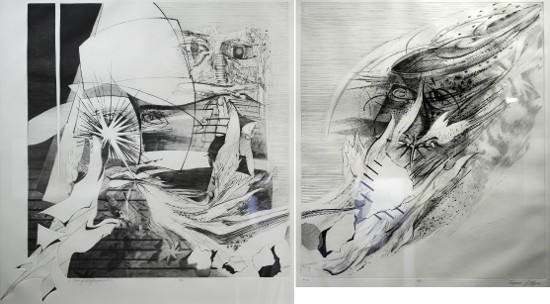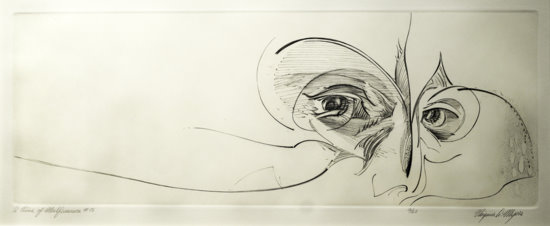What kind of person habitually lies, cheats, and steals? In the exhibit A Time of Malfeasance at the Figge Art Museum, printmaker Virginia Myers visualizes corruption through the psychological landscapes in which its perpetrators reside.
Malfeasance refers to a public official abusing his or her post, either through illicit or harmful endeavors. The early 1970s, when these works were created, was a period of political turmoil - Vietnam, Watergate, oil embargoes, and economic recession. Although this historical context was a likely influence on Myers, the artist doesn't reference these events specifically; instead, she abstracts the mindset of the participants.
Myers has been a professor in the University of Iowa Fine Arts Department since 1962 and has been working in printmaking for more than 50 years. The Malfeasance prints were made using dry-point etching, a process in which the artist scratches the image into a copper plate, inks the surface, and prints it with a press onto paper.
The show includes 21 individual prints, with six framed in pairs. The largest of the group measures roughly three by two-and-a-half feet, with the smaller works sized approximately 10 by 12 inches. Completed in 1974, this series was gifted to the Figge by collector Herbert Tyler. These works, located on the second floor, will be on display through October 14.
All of Myers's prints in this show prominently feature people - specifically, their faces and hands. The body of work could be divided into two main approaches: the simple and secretive, and the complex and chaotic.
Although more subdued, the simpler images have a clear aura of suspicion, or hiding, communicated through the gestures and facial expressions of their subjects. Their sparse backgrounds make the subjects appear totally alone, as if isolated by their own betrayals. Although it's apparent that many of the subjects are guilty parties, some works are ambiguous; corruption inspires suspicion on the part of constituents, as well.
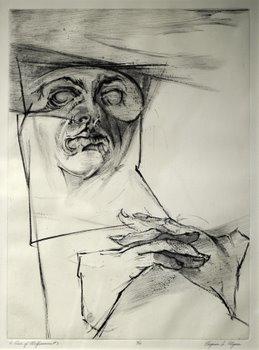 A standout print, alluring with the subject's iris-less, gaze, is A Time of Malfeasance #3. A stern, gender-ambiguous face, realistic except for its oversize blank eyes, looks down its nose at the viewer. The outline of its head has been replaced with a fuzzy trapezoid, giving the impression of a flat plane behind the head. The figure's hands rest in the foreground, fingers intertwined in a contemplative pose. The background is white, and the piece lacks rendering but for the face. The creepiness of the white-eyed stare, ambivalent expression, and hand gesture reminds me of the fat-cat villain archetype. The subject's downward gaze suggests our inferiority to this figure. Although the portrait is enigmatic, it clearly portrays those in authority viewing others through a lens of power.
A standout print, alluring with the subject's iris-less, gaze, is A Time of Malfeasance #3. A stern, gender-ambiguous face, realistic except for its oversize blank eyes, looks down its nose at the viewer. The outline of its head has been replaced with a fuzzy trapezoid, giving the impression of a flat plane behind the head. The figure's hands rest in the foreground, fingers intertwined in a contemplative pose. The background is white, and the piece lacks rendering but for the face. The creepiness of the white-eyed stare, ambivalent expression, and hand gesture reminds me of the fat-cat villain archetype. The subject's downward gaze suggests our inferiority to this figure. Although the portrait is enigmatic, it clearly portrays those in authority viewing others through a lens of power.
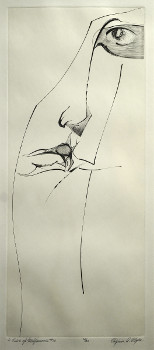 A Time of Malfeasance #10 is even quieter, visually, but offers a sense of mystery. This portrait appears more feminine; we see a single eye, a pursed mouth, and a delicate nose. Only three-quarters of the face is visible, and Myers has obscured the remainder, implying peeking through a curtain, or hiding behind hair, through the use of a thin sinuous line on both sides of the visible center of the face. The measuring expression in the eyes portrays suspicion rather than fear. The delicate linework and features make this portrait seem less threatening, but the sidelong glance and partially hidden face give the feeling of a covert agenda.
A Time of Malfeasance #10 is even quieter, visually, but offers a sense of mystery. This portrait appears more feminine; we see a single eye, a pursed mouth, and a delicate nose. Only three-quarters of the face is visible, and Myers has obscured the remainder, implying peeking through a curtain, or hiding behind hair, through the use of a thin sinuous line on both sides of the visible center of the face. The measuring expression in the eyes portrays suspicion rather than fear. The delicate linework and features make this portrait seem less threatening, but the sidelong glance and partially hidden face give the feeling of a covert agenda.
Another simple work implying a calculative ruse is A Time of Malfeasance #15. This strongly horizontal composition features just the eyes and the bridge of a nose in the right half of the composition, with a single line swooping across the left half. The eyes peer at the viewer, with a blank expression. Myers has exaggerated the angular qualities of the rendering around the eyes, and embellished the brow ridge and cheekbones with an oval-shaped perimeter, making the eyes seem part of a fancy, Mardi Gras-like mask, or an inhuman face. The line swooping into nowhere on the left implies that the face is in motion, all the while keeping its gaze locked. The keen stare suggests shrewdness, but the distorted mask elements and suggested gliding movement hint at a plan in action.
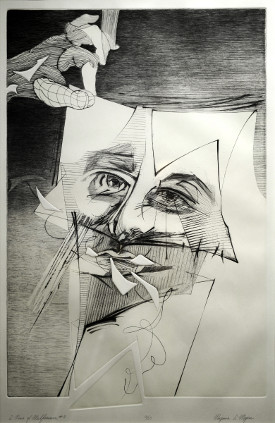 A Time of Malfeasance #8 is visually busier, with denser linework and more ink on the page. The background is a gradient from dark at the top to white at the bottom, giving this figure a subtle sense of spatial context. He appears bemused, looking up, with a slight tilt to his head. A hand emerges from the top left of the print, carefully pinching a flat white shape that appears to be either part of or directly behind the abstracted, angular face. It's unclear if the hand is depositing or taking this shape. Other forms like cut paper are poking out of his closed lips, either being expelled or gobbled up. The ambiguity of taking or receiving hints at the cycle of money and favors between malefactors. Although this might seem an overly political interpretation, the clear reference to "paper" and the blunt titling of the exhibit insist upon this consideration. The more amused expression in this work stands out from the rest; while the others are more powerful or paranoid, this work appears to reference the glib or entitled qualities of malfeasance.
A Time of Malfeasance #8 is visually busier, with denser linework and more ink on the page. The background is a gradient from dark at the top to white at the bottom, giving this figure a subtle sense of spatial context. He appears bemused, looking up, with a slight tilt to his head. A hand emerges from the top left of the print, carefully pinching a flat white shape that appears to be either part of or directly behind the abstracted, angular face. It's unclear if the hand is depositing or taking this shape. Other forms like cut paper are poking out of his closed lips, either being expelled or gobbled up. The ambiguity of taking or receiving hints at the cycle of money and favors between malefactors. Although this might seem an overly political interpretation, the clear reference to "paper" and the blunt titling of the exhibit insist upon this consideration. The more amused expression in this work stands out from the rest; while the others are more powerful or paranoid, this work appears to reference the glib or entitled qualities of malfeasance.
The second component of the exhibit consists of turbulent compositions with more figures and visual embellishments. These works appear less about the mindset of the malfeasant individuals and more about their interactions with others, showing relationships between powerful figures and their victims.
Exhibiting an unusual yet effective presentation and application of the print medium are A Time of Malfeasance #11 and #12. The two are framed together, and appear more as a diptych than separate works, with compositions that flow together.
Part of what makes this image so striking is the atypical use of the printing plates. Instead of engraving the whole image onto a rectangular plate, Myers used custom-shaped plates, allowing for key areas of the composition to remain untouched by the press. This results in areas retaining the bright white and unindented relief of the original paper. The shattered, gauntleted texture of a hand and the bright burst of a spark are enhanced as focal points because of this method.
The hand, appearing covered in angular shapes, emerges from the left corner of #11 with a spark flashing from a finger. Partially obscured by the hand is a face, from whose mouth flows a stream of lines and shapes, full of fire-like and organic forms. This "stream" crosses the space between the two prints, then coalesces into a face, which composes the subject of #12.
This portrait, on the right in #12, appears to be suppressing rage, with an exaggeratedly pinched mouth and bulging eyes. His head appears to fade into the distance, with repeated curved lines suggesting rapid motion or wind moving to the upper right corner. Flame-like shapes hover in front of his face - the hand in #11 kindling or attempting to extinguish them.
Both the stream and spark could represent the potential of those in power to create or destroy, with the hands and mouth representing action and words, respectively. A different face resides in #11, with a hand emerging from below to press his lips shut. This seems to be another reference to the power to silence.
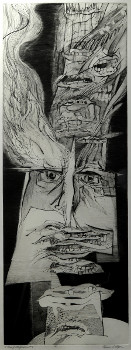 A Time of Malfeasance #9 uses a packed, disorderly style, employing a repeated motif of talking mouths. A rectangular, worried-looking face is the focal point in the center. The head appears as part of a totem-pole-like composition, with various mouths haphazardly stacked above and below the face. A smoke-like pillar wafts from above the left eye of the face, drifting off the left top corner of the image. Some of the mouths also appear to be releasing an exhalation that resembles smoke and abstracted botanical motifs. The disembodied mouths are rendered with scratchy lines, giving a creepy effect. Their seemingly disjointed arrangement creates a cacophony - one can almost hear them talking over one another. This seems to be another reference to the power of words - this time as a way to confuse.
A Time of Malfeasance #9 uses a packed, disorderly style, employing a repeated motif of talking mouths. A rectangular, worried-looking face is the focal point in the center. The head appears as part of a totem-pole-like composition, with various mouths haphazardly stacked above and below the face. A smoke-like pillar wafts from above the left eye of the face, drifting off the left top corner of the image. Some of the mouths also appear to be releasing an exhalation that resembles smoke and abstracted botanical motifs. The disembodied mouths are rendered with scratchy lines, giving a creepy effect. Their seemingly disjointed arrangement creates a cacophony - one can almost hear them talking over one another. This seems to be another reference to the power of words - this time as a way to confuse.
Myers' prints fuse a mastery of a traditional and technically challenging medium with a modern illustrative style, and explore a relatively specific theme in an open, expressive way. Her employment of both sparse and chaotic visual approaches reflects the conniving yet ruthless qualities of a person in power who would betray the public trust.
Michelle Garrison is a mixed-media artist who teaches art and design at Geneseo Middle School. She can be reached at michelle_m_garrison@hotmail.com.

